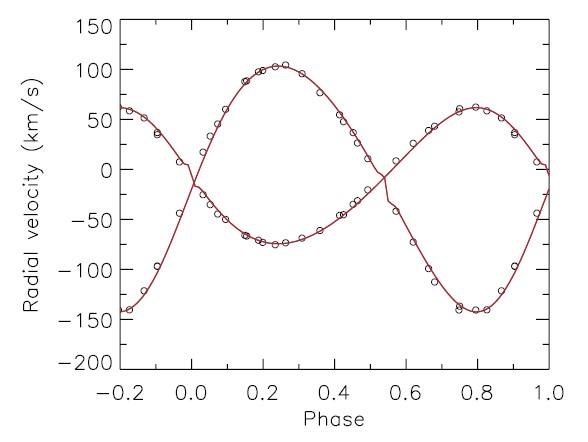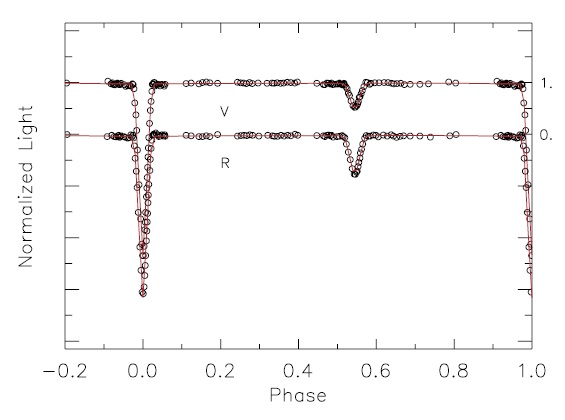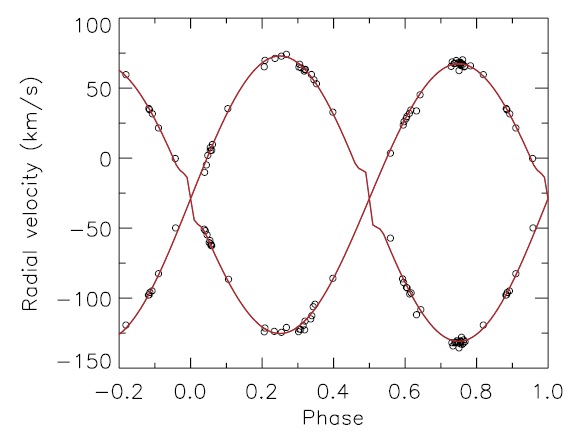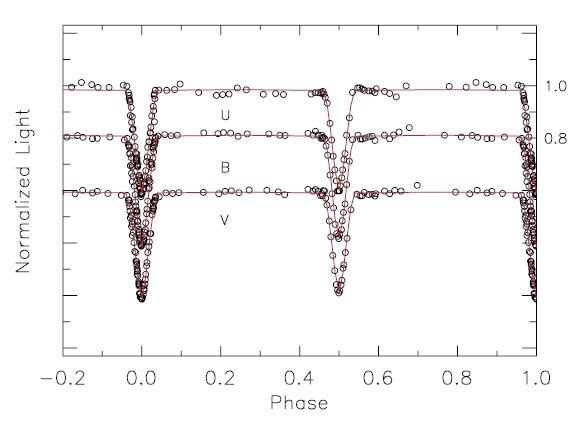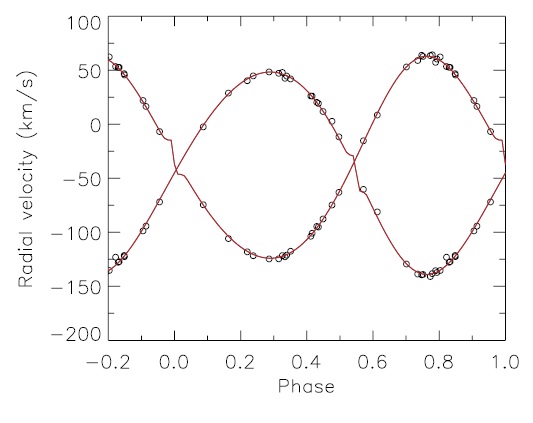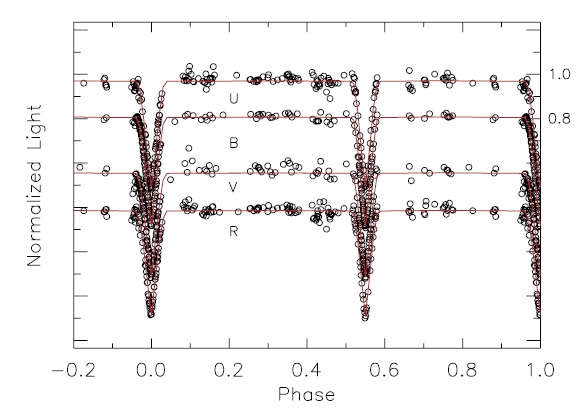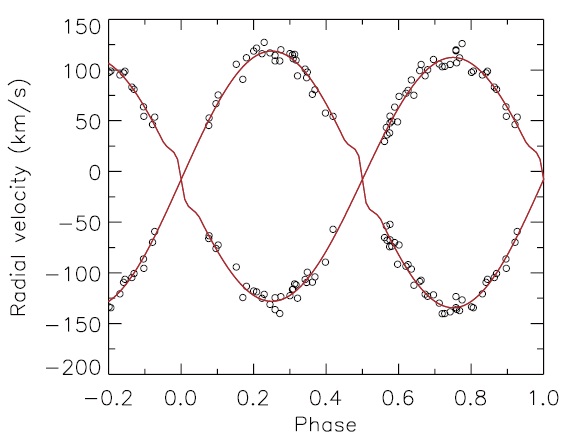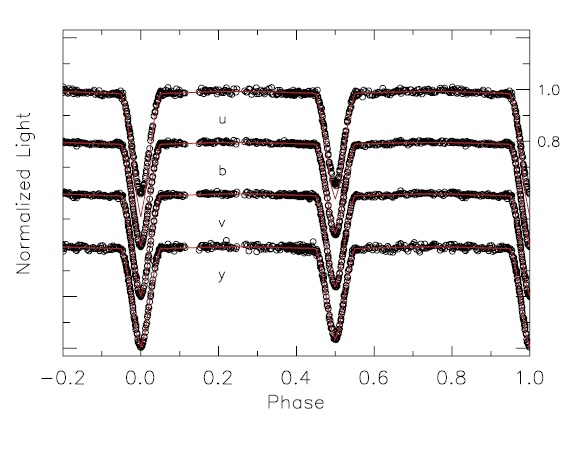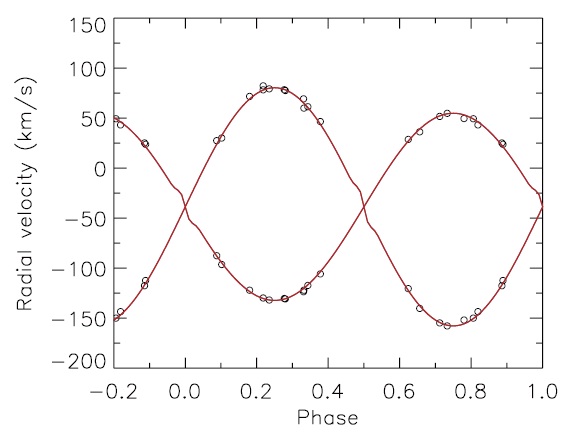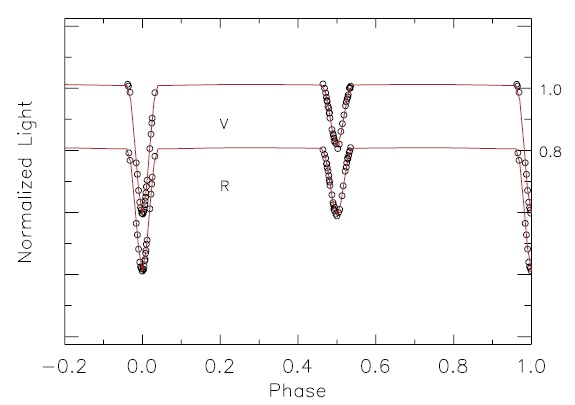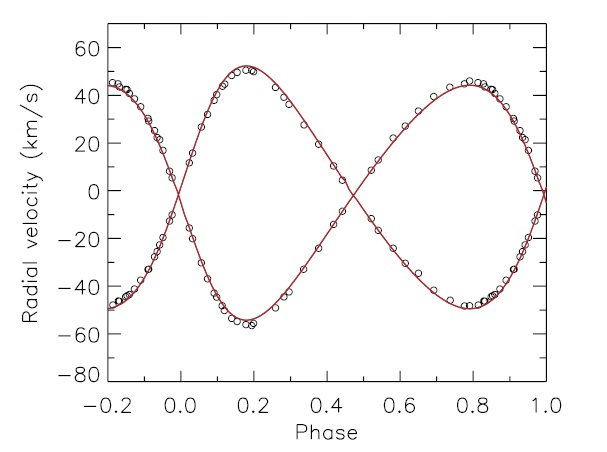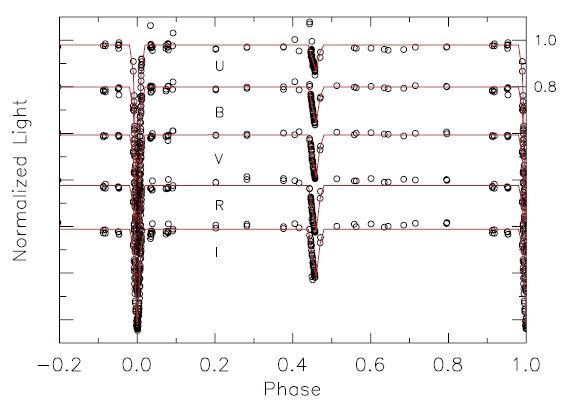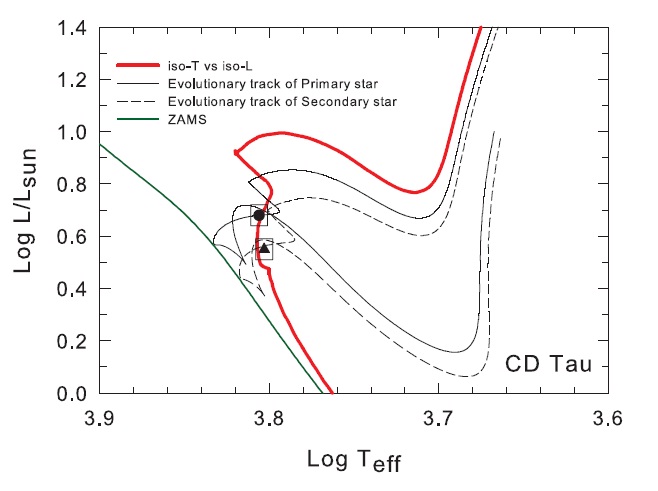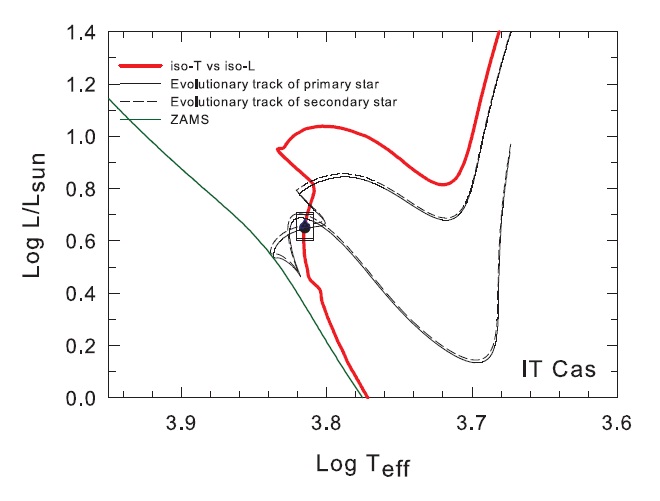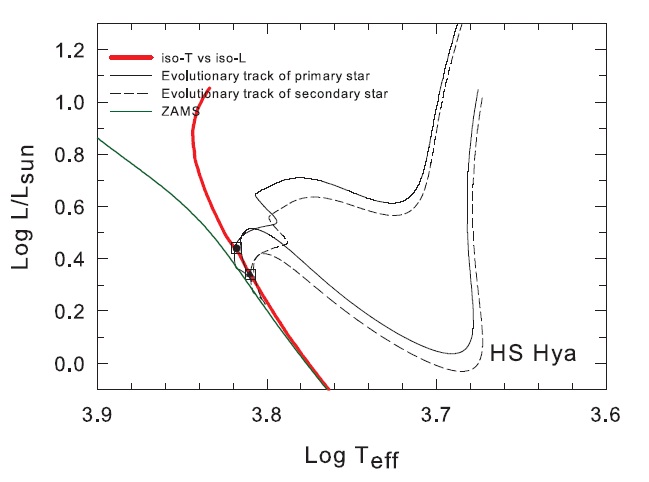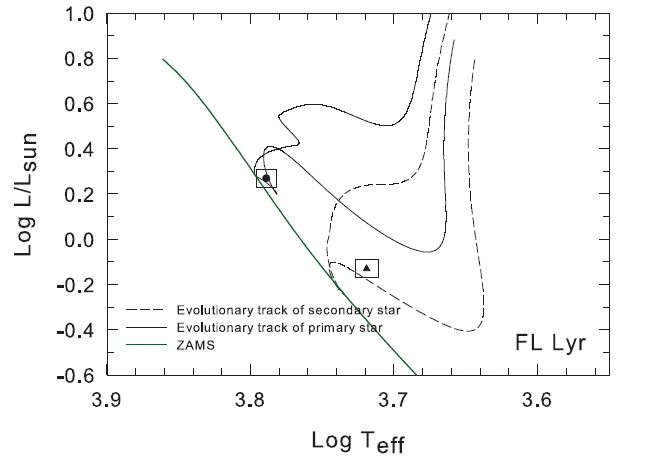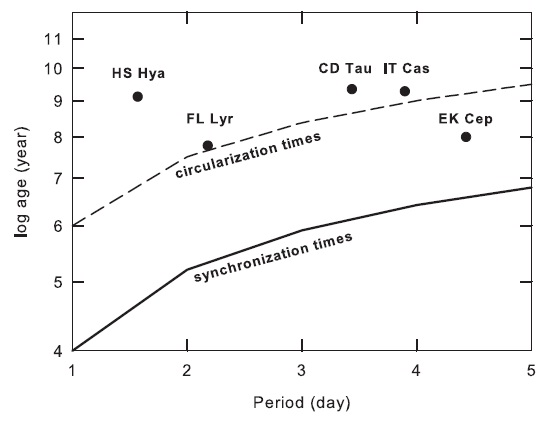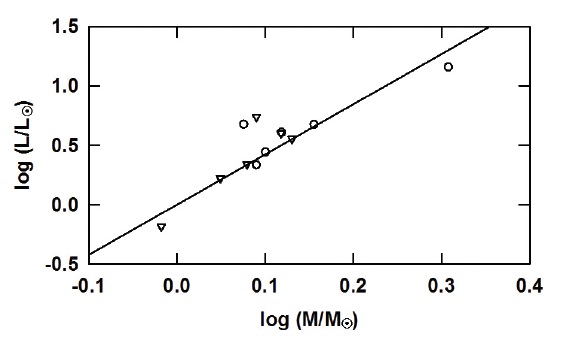



Photometric observations of eclipsing binaries produce light curves whose morphologies provide relative parameters of the binary systems, while the size of semi-major axis can be determined in mks unit using radial velocity curves produced by spectroscopic observations of the binaries. Therefore the eclipsing double lined spectroscopic binaries provide fundamental parameters such as stellar masses and radii. Even luminosities and distances can be determined if temperature can be assigned to the component stars.
In this paper we investigated six solar type double lined spectroscopic eclipsing binaries for their evolutionary statuses which include absolute their dimensions, evolution tracks, isochrones, and ages. Generally the evolution models (Yi et al. 2003, Bertelli et al. 2009, Ekstr?m et al. 2012) have been used to determine the evolutionary statuses of stars in clusters. Our aim is to find the evolutionary statuses of field stars using detached eclipsing binaries. This work is expected to cross check the fundamental stellar parameters.
The absolute dimensions were determined in Section 2, the evolution tracks were calculated in Section 3. Finally we discussed and summarized our results in Sections 4 and 5, respectively
We collected well-detached eclipsing binary systems which not only show no interactions between components but also provide multi color light curves and double-lined radial velocity curves for the purpose of stellar fundamental parameters. Thus far, we first have collected approximately 80 eclipsing detached binary stars. We first analyzed first six solar type detached eclipsing binary systems whose mass range between 0.9 and 1.4 solar masses. The ephemerides of six detached binary systems are listed in Table 1.
Double lined radial velocity curves were analyzed using the 2007 version of Wilson & Devinney (1971) differential correction computer code for spectroscopic parameters. The system velocity (V
For the photometric parameters we estimated effective temperatures of the binary systems using their color indexes of the binary systems, and relation between color index (
[Table 1.] The ephemerides of six detached binary systems.

The ephemerides of six detached binary systems.
[Table 2.] The system temperatures of six detached binary systems.

The system temperatures of six detached binary systems.
[Table 3.] Spectroscopic and photometric solutions of six detached binary systems.

Spectroscopic and photometric solutions of six detached binary systems.
[Table 4.] Absolute dimensions of six detached binary systems.

Absolute dimensions of six detached binary systems.
binary systems determined by spectral types. The temperatures of six detached binary systems are listed in Table 2.
The temperatures determined by color index of CD Tau, HS Hya, IT Cas, and FL Cep show good agreement with those of spectral types, while EK Cep and AI Phe show deviation between temperatures by color index and by spectral type. This is mainly due to the incorrect collection of color excess in the literatures. Therefore we used temperatures determined by spectral types. We assumed the temperature of the binary system to be an initial temperature of the primary star. Later the binary system temperatures were divided into temperatures of primary and second stars (Kang et al. 2004). The system temperatures are listed in Table 2. The mass ratio and semi major axis determined in the analysis of radial velocity curves were adopted. The initial values of limb darkening coefficients (x1, x2) were adopted from the theoretical mean values of van Hamme (1993). The gravitational darkening coefficients (g1, g2), were assumed to 0.32 for convective envelope and 1.0 for radiative envelope suggested by Lucy (1967). The bolometric albedos (A1, A2) are 0.5 and 1.0 for convective envelope and radiative envelope, respectively. These parameters were then adjusted, if necessary.
The theoretical light curves were fitted to the observed light curves by adjusting parameters which include temperature, relative radii, and other photometric parameters. The spectroscopic and photometric parameters were combined to determine absolute dimensions of the detached eclipsing binary systems. The photometric parameters and absolute dimensions are listed in Table. 3 and 4, respectively. Brief research histories and current interesting topics of each binary system are described below.
EK Cep was discovered to be an eclipsing binary system by Strohmeier (1959). The photometric observations were carried out by Ebbighausen (1966a), Khaliullin (1983), and Hill & Ebbighausen (1984). Spectroscopic observations were published by Ebbighausen (1966b) and Tomkin (1983). Later, the evolution of EK Cep was studied by various investigators (Popper 1987, Martin & Rebolo 1993, Claret et al. 1995, Palla & Stahler 2001, Yildiz 2003, Marques et al. 2004, Claret 2006). We analyzed the radial velocity curves of Tomkin (1983) and the
CD Tau (HD 34335, HIP 24663) was found to be a double lined spectroscopic binary by Sanford (1928). Wesselink (1932) found it to be an eclipsing binary. Popper (1971) published radial velocity curves. Photometric observations were carried out by three different investigators (Srivastava 1976, Wood 1976, Gulmen et al. 1980). The light curve analyses had been carried out by Gulmen et al. (1980) and Russo et al. (1981). The radial velocity curves had been analyzed by Popper (1971) and Ribas et al. (1999), respectively. The evolution of CD Tau was studied by Ribas et al. (2000).
CD Tau is known as a possible member of a triple system (Chambliss 1992). It has a K-type close visual companion (CD Tau C). We analyzed combined radial velocity curves observed by Popper (1971) and Torres et al. (1997). The
IT Cas was discovered to be an eclipsing binary system by Fadeeva (Parenago 1938). Lacy et al. (1997) published
Cas. We analyzed radial velocity and light curves for their absolute dimension. The orbit of IT Cas is an eccentric orbit and show apsidal motion. The fitted radial velocity and light curves are plotted in Figs. 5 and 6, respectively.
HS Hya (HD 90242) was discovered to be an eclipsing binary star by Strohmeier et al. (1965). The spectroscopic observations were published by Popper (1971) and Torres et al. (1997). Gyldenkerne et al. (1975) carried out the photometric observations. The light curves had been analyzed by Gyldenkerne et al. (1975) and Giuricin et al. (1980). HS Hya has a third star in the system (Torres et al. 1997). The third star is a M0 dwarf with 0.5 solar mass and 190 day orbit.
The combined radial velocity curves observed by Popper (1971) and Torres et al. (1997), and
FL Lyr was discovered to be a detached eclipsing binary system by Popper et al. (1986). The first light curves of this system were published by Cristaldi (1965).
We analyzed radial velocity curves published by Popper et al. (1986) and
AI Phe was discovered to be an eclipsing binary system by Strohmeier (1972). The spectroscopic observations were carried out by Imbert (1979) and Andersen et al. (1988). The
stars of AI Phe are known as evolved stars. We analyzed the radial velocity and light curves published by Hrivnak & Milone (1984) and by Andersen et al. (1988), respectively. The fitted radial velocity and light curves are plotted in Figs. 11 and 12, respectively.
3. EVOLUTION TRACKS OF 6 DETACHED SYSTEMS
The evolution tracks of six detached eclipsing systems were computed using the Yale stellar evolution code (Guenther et al. 1992). Cemical mixture is assumed to be the scaled solar value introduced by Grevesse & Sauval (1998) because targets are solar neighborhood with mass range (0.9 ~ 2.0 M⊙ ). Two opacity sets have been used in computation of transport of radiant energy. OPAL opacities (Iglesias & Rogers 1996) for interior and low temperature opacities (Ferguson et al. 2005) for outer region have been considered, respectively. These two opacity sets are in a good agreement in the overlapping region.
[Table 5.] Chemical compositions and ages of six detached binary systems.

Chemical compositions and ages of six detached binary systems.
We plotted the location of a given star with propagation error (box) using their luminosity and temperature on Hertzsprung-Russell diagram. The horizontal axis of the diagram is the effective temperature, Log (Teff) and vertical axis is luminosity, Log (L/L⊙ ). We plot evolution tracks using several parameter sets for a given star. Then we adjusted Y⊙ and Z⊙ values until the evolution track satisfy the primary and secondary stars and their isochrones. The evolution tracks and isochrones for six detached systems are plotted in Figs. 13-18. Each plot shows zero age main sequence (green line), evolution tracks for primary (black line) and secondary (black dotted) stars of each binary system, and isochrones (red thick line).
According to the fitted evolution tracks, EK Cep and FL Lyr belong to zero age main sequence. HS Hya, IT Cas and CD Tau are on the main sequence and their ages are 1.3, 1.9 and 2.2 Gyr, respectively. Both component stars of AI Phe evolved to sub giants and its age is 4.3 Gyr. Chemical compositions and ages of six binary systems are listed in Table 5.
We investigated evolution tracks, isochrones, and ages of the six detached binary stars. EK Cep and FL Lyr belong to the zero age main sequence. HS Hya and IT Cas are on the main sequence and their ages are 1.3, 1.9 and 2.2 Gyrs, respectively. Both component stars of AI Phe binary system evolved to sub giants and its age is 4.3 Gyrs. Those ages of the detached binary systems shows good agreement with the time for synchronization and circularization of the binary systems.
It is gerally accepted that a binary star formed with an eccentric orbit which becomes circular orbit. The rotaion of star synchronized to their orbital motion. It is due to the tidal forces in close detached binary stars. The tidal forces drive an exchange of angular momentum between the rotation of the stars and their orbital motion. The theory of orbital pertubations caused by tidal forces between the components of close binaries has been studied by Zahn (1975, 1977, 1978, 1989, 1992). The cumulative effects of such tidal interactions with time is referred to as tidal evolution. The characteristic signs of tidal evolution are
1) alignment of the stellar spin axes perpendicular to the orbital plane; 2) synchronization of the rotation of the stars to the orbital motion; and 3) circularization of the orbits (Meibom et al. 2006). Hilditch (2001) summerized rough time scales of the synchronization and the circularization for convective envelope stars as below
where the orbital period is in days.
These equations show that the time scales strongly depend on the orbital period. The ages determined by evolution tracks were compared with the time scales of synchronization and circularization in Fig. 19. The time limits for synchronization and circularization were calculated using above two equations. and were plotted against orbital period in Fig. 19.
The evolution tracks of CD Tau and HS Hya determined their ages as 1.9 Gyrs and 1.3 Gyrs, respectively. Their solutions of light and radial velocity curves show both binary systems have been syncronized and their orbits are circular. The analyses of light and radial velocity curves for CD Tau and HS Hya binay systems do not show eccentricity and asynchronization in their orbits. Therefore ages determined by evolution tracks of these binary systems are good agreement with time scales of synchronization and the circularization. The evolution tracks of EK Cep shows that both components are on the zero age main sequence.The analyses of light and radial velocity curves show that EK Cep has an eccentric orbit (e = 0.10) but its rotaion is synchronized to the orbital motion. Therefore it passed synchronization period, but it is still on the circularization period. We can assume its age approximaly between 107
Gyr and 109 Gyr. EK Cep also show good agreement with those of tital evolution theory. AI Phe is not plotted becaue of the period of AI Phe is too long compared those of other systems. The age determined by evolution tracks of AI Phe is 4.3 Gyr. It has been passed the period of tidal evolution.
The mass?lumonosity relation is plotted using component stars of six detached eclipsing binares in Fig. 20. The open circles and triangles stand for primary and secondary stars, repectively. All stars show good agrrement except two stars which are component stars of AI Phe whose components are evolved to sub giant stars. The component stars of five binary systems shows the mass?luminosity relation as below
This relation shows good agrement with the mass ? luminosity relation for mass range between 0.43
The radial velocity and light curves collected in the literatures for six detached eclipsing binaries were analyzed using the Wilson & Devinny (1971) differential correction program. The findings for these analyses are summarized as follows:
(ⅰ) The fundamental parameters which include masses, radii, temperatures, luminosities of both component stars in the six binary systems are obtained.
(ⅱ) The evolution tracks, isochrones, ages, metal abundances of six binary systems are obtained.
(ⅲ) Ages of six binary systems were confirmed by comparing with time period of synchronization and circularization of a binary system. The ages of the binary systems show good agreement with the time period of tidal evolution period Therefore we found absolute dimensions of six stars are well matched to their evolutionary statues.




